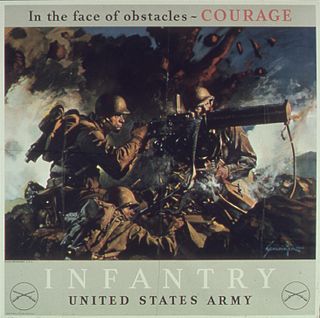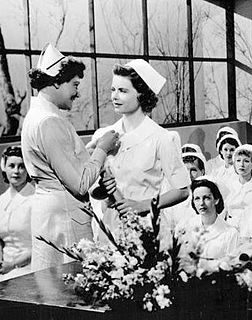
The Battle of San Pietro is a documentary film directed by John Huston about the Battle of San Pietro Infine sixty miles from Naples during World War II. It was shot by Jules Buck. It was released in the U.S. in 1945 but shown to U.S. troops earlier.

The United Service Organizations Inc. (USO) is an American nonprofit-charitable corporation that provides live entertainment, such as comedians, actors and musicians, social facilities, and other programs to members of the United States Armed Forces and their families. Since 1941, it has worked in partnership with the Department of War, and later with the Department of Defense (DoD), relying heavily on private contributions and on funds, goods, and services from various corporate and individual donors. Although it is congressionally chartered, it is not a government agency.

United States civil defense refers to the use of civil defense in the history of the United States, which is the organized non-military effort to prepare Americans for military attack. Late in the 20th century, the term and practice of civil defense fell into disuse. Emergency management and homeland security replaced them.

The United States home front during World War II supported the war effort in many ways, including a wide range of volunteer efforts and submitting to government-managed rationing and price controls. There was a general feeling of agreement that the sacrifices were for the national good during the war.

The Battle of Midway is a 1942 American short documentary film directed by John Ford. It is a montage of color footage of the Battle of Midway with voice overs of various narrators, including Johnny Governali, Donald Crisp, Henry Fonda, and Jane Darwell.

Hymn of the Nations, originally titled Arturo Toscanini: Hymn of the Nations, is a 1944 film directed by Alexander Hammid, which features the Inno delle nazioni, a patriotic work for tenor soloist, chorus, and orchestra, composed by Italian opera composer Giuseppe Verdi in the early-1860s. For this musical work, Verdi utilized the national anthems of several European nations.

Ring of Steel is a 1942 short documentary film directed by Garson Kanin and narrated by Spencer Tracy. "Dedicated to the American Soldier", the film was released on April 2, 1942, and distributed free to all U.S. theaters. The film was produced by Warner Bros. and the United States Office for Emergency Management.

Gracias Amigos was a 1944 propaganda short produced by the Office of the Coordinator of Inter-American Affairs to educate the American public about the contributions of Latin America during World War II.

Blitz Wolf is a 1942 American animated propaganda short film produced and distributed by Metro-Goldwyn-Mayer. A parody of the Three Little Pigs told via a World War II perspective, the short was directed by Tex Avery and produced by Fred Quimby. It was nominated for the Academy Award for Best Short Subject: Cartoons but lost to Der Fuehrer's Face, another anti-Nazi World War II parody featuring Donald Duck.

During active American involvement in World War II (1941–45), propaganda was used to increase support for the war and commitment to an Allied victory. Using a vast array of media, propagandists instigated hatred for the enemy and support for America's allies, urged greater public effort for war production and victory gardens, persuaded people to save some of their material so that more material could be used for the war effort, and sold war bonds. Patriotism became the central theme of advertising throughout the war, as large scale campaigns were launched to sell war bonds, promote efficiency in factories, reduce ugly rumors, and maintain civilian morale. The war consolidated the advertising industry's role in American society, deflecting earlier criticism. The axis leaders were portrayed as cartoon caricatures to make them appear foolish and idiotic.
Tuesday in November was a propaganda short about the 1944 United States presidential election produced by the Office of War information for overseas distribution. It is meant to explain how the democratic process in America works.
Two Down and One to Go was a short propaganda film produced in 1945 directed by Frank Capra; as its title might suggest, its overall message was that the first two Axis powers, Italy and Germany, had been defeated, but that one, Japan, still had to be dealt with.

Beyond the Line of Duty is a 1942 American short propaganda film, directed by Lewis Seiler. The documentary film reenacted the life and career of United States Army Air Corps Captain Hewitt T. "Shorty" Wheless.

So Much for So Little is a 1949 American animated short documentary film directed by Chuck Jones and Friz Freleng. In 1950, it won an Oscar at the 22nd Academy Awards for Documentary Short Subject, tying with A Chance to Live. It was created by Warner Bros. Cartoons for the United States Public Health Service. As a work of the United States Government, the film is in the public domain. The Academy Film Archive preserved So Much for So Little in 2005. Produced during the Harry S. Truman administration, it attained renewed relevance during the modern Medicare for All movement in the United States nearly seven decades later.
Journey into Medicine is a 1947 American documentary-style film. The film stars James Karen as Michael Kenneth Marshall, a young medical student who goes through medical training at Columbia and Cornell. During his internship in pediatrics, Marshall loses one of his patients, a young girl to diphtheria. This case inspires him to enroll in the Johns Hopkins School of Public Health and pursue a career in public health. While studying at Johns Hopkins, Marshall helps battle an outbreak of diphtheria in Baltimore, which confirms to him his chosen vocation.

Bomber: A Defense Report on Film is a 1941 American short documentary film produced by the United States Office for Emergency Management, and was edited from the 19-minute Building a Bomber: A Defense Report on Film (1941). The film commentary was written by Carl Sandburg.
It's Your War Too is a 1944 short documentary film about the American Women's Army Corps and commissioned by the United States Government during World War II. It contains 1 minute of animation by the Walt Disney Studios.
Food and Magic is a 1943 short documentary film commissioned by the United States Government during World War II. Food and Magic, was produced by the War Activities Committee of The Motion Picture Industry and it deals with food conservation and healthy eating. It stars Jack Carson as a sideshow barker who informs the crowd about proper wartime food consumption, including conservation and rationing.
Since Pearl Harbor is a 1943 short documentary film commissioned by the United States Government during World War II. It is a "report to the American People" regarding the wartime activities of the American Red Cross since the Attack on Pearl Harbor.

Reward Unlimited is a short film produced in 1944 by David O. Selznick's Vanguard Films, for the United States Public Health Service, dramatizing the need for volunteer military nurses for the U. S. Cadet Nurse Corps during World War II. Directed by Jacques Tourneur, the 10-minute film stars Dorothy McGuire in one of her first films. The story by Mary C. McCall, Jr., dramatizes the choice that young Peggy Adams makes to become a nurse, her training, and her volunteering for military nursing service. The cast includes Aline MacMahon, James Brown, Spring Byington and Tom Tully.














